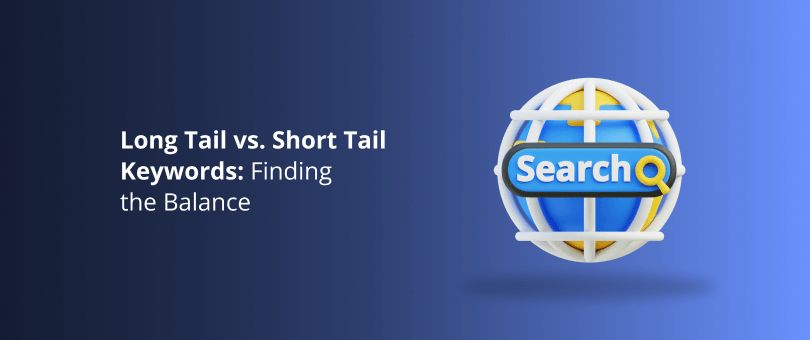Keywords are the essence of search engine optimization. More so, picking the right keywords for your website can be vital to the success of your business.
What is more, you need to find a balance between using short-tail and long-tail keywords, to increase your chances of getting maximum online visibility, and drive the most traffic to your site.
But what is the whole story of long-tail vs short-tail keywords? Join us for the breakdown, and learn how to use both efficiently.
Readers Also Enjoy: Keyword Mapping for SEO: The Ultimate Guide – DevriX
What Are Long Tail Keywords?
Long tail keywords, as the name suggests, are longer keywords, typically consisting of three or more words. On top of that, they usually have a lower search volume, and low competition.
These keywords are also more specific than short ones, which more often than not, results in higher conversion rates. They are also easier to rank for.
Readers Also Enjoy: 7 Ways to Use Long-Tail Keywords in Your SEO Strategy – DevriX
What Are Short Tail Keywords?
On the other side of the keyword spectrum – short tail keywords are, as implied, shorter keywords, made of one or two words. They generally have a high search volume, although that is not necessarily true for all of them.
Such key phrases are broad, therefore, harder to rank for, and tend to have a lower conversion rate.
| Long Tail Keywords | Short Tail Keywords |
| Three words or more | One or two words |
| Lower search volume | Higher search volume |
| Higher conversion rate | Lower conversion rate |
| Less competitive | Highly competitive |
Readers Also Enjoy: Website Metrics That Matter [And You Should Track] – DevriX
Long Tail vs. Short Tail Keywords: A Comparison
Both short-tail and long-tail keywords have their role in the proper search engine optimization of your website. The key is to know when to use each, and how to balance them.
When Is It Better to Use Long Tail Keywords?
Long keywords are more specific, and therefore more likely to match the search intent of users, which results in a higher chance of conversions.
Not only are you more likely to benefit from these keywords, but you will also attract your target audience as well as raise your chances of ranking well in the SERPs.
For instance, you want to write a blog post about your sunscreen products.
You would be better off choosing the long tail keyword “benefits of wearing sunscreen” (110 search volume), than “sunscreen” (74,000 search volume).
The first is specific, aimed at users who want to learn more about the benefits of sunscreen, while the latter is vague, and could be anything related to sunscreen.
Your likelihood of converting is higher too with the lower volume phrase, because a.) you are much more likely to rank among the top 10 search results for it, and b.) you immediately let people know what the page is about.
The keyword “sunscreen” is very unlikely to be successful, because a.) you will almost certainly not be among the top 10 search results, and b.) it won’t be easy to understand what the page is about until they enter it, and if it does not match their intent, users will likely hit the exit button right away.
Readers Also Enjoy: 9 Blogging Tips and Tricks to Skyrocket Your Content [and SEO] In 2022 – DevriX
When Is It Better to Use Short Tail Keywords?
Due to the general nature of short keywords, their primary use is to rank for broad terms and attract a wide range of visitors. Think about main topics, categories, and pages.
Taking the example from above, if you have sunscreen products, it would be a good idea to use the term “sunscreen” as a category and then have some more specific pages or posts like “sunscreen for dry skin”, “sunscreen for outdoor sports”, “vitamin C sunscreen”, etc.
Additionally, it would be better to target short tail keywords for important pages, like your homepage. In this case, going for a key phrase such as “sunscreen” (74,000 volume), or “best sunscreen for face” (22,200 volume) would make more sense, as you want to attract more potential customers.
Of course, all of these keyword research steps should be carefully thought out, and adjusted accordingly to your business needs, and the current status of your website.
Naturally, big industry players whose names are almost synonymous with the products would find it easier to rank for such competitive terms, while a small business will have zero to no chances of doing so.
In the second scenario, long tail keyword research could prove to be quite fruitful, since it can provide a low competition field to occupy, and slowly grow onto the more competitive search engine results pages.
Readers Also Enjoy: What Is SEO Forecasting [How Can It Help Your Business Grow?] – DevriX
How to Find Long Tail Keywords?
You can use several methods to find long-tail keywords. The most basic approach involves Google. You use the autocomplete function to find longer versions of basic key phrases.
For example, you type in “lasagna”, and get different results like “lasagna bolognese”, “lasagna calories”, “lasagna ingredients”, and so on. Each of these terms can provide other long-tail keywords, like “lasagna calories per serving”, “lasagna bolognese with ricotta”, “lasagna ingredients order”, etc.
In addition, you can also look at the “People Also Ask”, and Related searches to get even more ideas on long keywords.
Also, you can use keyword research tools like Semrush, Ahrefs, and Uber Suggests, which will allow you to enter a seed (short) keyword and then narrow your results through filters for search volume, keyword difficulty, competition score, and various other data.
Readers Also Enjoy: Tracking Google Keyword Ranking: Why and How? – DevriX
How to Find Short Tail Keywords?
In essence, you can use the same methods to find short keywords. Analyze the search engine results pages, and use keyword research tools.
Of course, you could also brainstorm for terms that are appropriate for your business and would make sense to target.
Readers Also Enjoy: SEO Automation: Cut Through These 8 Tasks for Better Results – DevriX
Summary
So, what is the main takeaway? Long tail vs. short tail keywords is not a competition, it is a matter of finding the right balance between using both types and understanding how to position them on your website.
Short keywords are more appropriate for categories, main topics, and pages, while long tail phrases are more suited to blog posts, and sub-topics.
Are you eager to learn more about marketing, or perhaps business? Don’t forget that our digital marketing services can help your business grow, and reach new heights.



